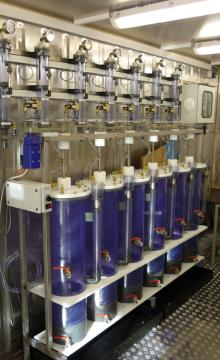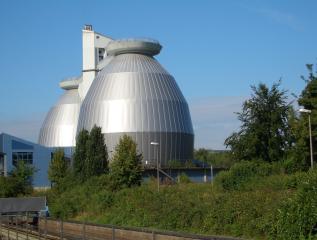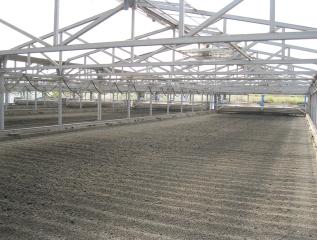 Optimization of sewage sludge management
Optimization of sewage sludge management
On the basis of the results of previous projects and with due regard to the success and cost effectiveness of the treatment, particularly promising sewage sludge management schemes such as anaerobic sludge stabilization, solar-based drying and thermal disinfection had been validated and optimized on an industrial scale under the specific boundary conditions obtaining in other countries.
Investigations relating to anaerobic sludge stabilization, solar-based drying and thermal disinfection
Design algorithms were being elaborated with regard to sludge treatment and solar-based drying; they were subsequently validated on industrial-scale plants based on the criteria of performance (process inventory and energy balance), the quality of the treated sewage sludge, and operating aspects. A pilot plant for the thermal disinfection facility for solar-dried sewage sludges installed downstream were developed and operated.
Process selection and requirements have been met by the sewage sludge treatment unit were evaluated with due regard to country and region-specific criteria; the same applies to arrangements for sewage sludge disposal.
Investigation sites:
Semi-scale test facilities for anaerobic stabilization were used on sewage treatment plants in Turkey. The investigations relating to solar-based drying and thermal disinfection were carried out on plants in Germany, Colombia and Poland.
 Focal points of operations:
Focal points of operations:
The following principal work packages (AP 1 and 2) were carried out; these were followed by a scientific/engineering assessment of the success of the treatment and of process operating stability:
- Anaerobic sewage sludge treatment (AP 1): In this work package, the design of the digestion plants were validated at low operating temperatures (25°C and higher) and there was a cohesive design algorithm has been elaborated for the anaerobic sludge stabilization process. To that end, characteristic performance values such as degree of decomposition and biogas yield as a function of temperature and the digestion period were examined; the investigations also covered variations in sludge properties and addition of a co-substrate for single and double-stage process control purposes. The disinfection performance were assessed. Operating and load parameters have been developed for small and medium-sized plants.
- Solar-based sewage sludge drying and thermal disinfection (AP 2)
 : This work package was designed to validate climatic-hydrological evaporation models (Penman and Turc/Wendling Model) and their modification and extension, and also to develop a pilot plant for thermal disinfection. In the process, the test programme taken into account, inter alia, the impact of substrate quality on drying performance and disinfection as a function of sludge solids content and microbial contamination. Furthermore, the impact on solar-based drying of factors such as summer/winter operation with/without extraneous heat input, the thickness of the sludge layer, sludge turnover intervals, and floor temperature, and the impact of factors such as temperature, filling volumes, mixing, and retention time on disinfection performance have been examined.
: This work package was designed to validate climatic-hydrological evaporation models (Penman and Turc/Wendling Model) and their modification and extension, and also to develop a pilot plant for thermal disinfection. In the process, the test programme taken into account, inter alia, the impact of substrate quality on drying performance and disinfection as a function of sludge solids content and microbial contamination. Furthermore, the impact on solar-based drying of factors such as summer/winter operation with/without extraneous heat input, the thickness of the sludge layer, sludge turnover intervals, and floor temperature, and the impact of factors such as temperature, filling volumes, mixing, and retention time on disinfection performance have been examined.
Project partners:
Technische Universität Carolo-Wilhelmina zu Braunschweig,
Institut für Siedlungswasserwirtschaft
Pockelsstr. 2a, 38106 Braunschweig
www.tu-braunschweig.de/isww
Persons to contact:
Prof. Dr. Norbert Dichtl, n.dichtl@tu-braunschweig.de
Dr. Katrin Bauerfeld, k.bauerfeld@tu-braunschweig.de
M.Eng. Robert Mieske, r.mieske@tu-braunschweig.de
Dipl.-Ing. Rosa Dellbrügge, r.dellbruegge@tu-braunschweig.de
Huber SE
Industriepark Erasbach A 1
92334 Berching
www.huber.de
Person to contact:
Dr. Albert Heindl, hal@huber.de
Oswald Schulze Umwelttechnik GmbH
Krusenkamp 22-24
45964 Gladbeck
www.oswald-schulze.de
Person to contact:
Dr. Jürgen Oles, droles@oswald-schulze.de







